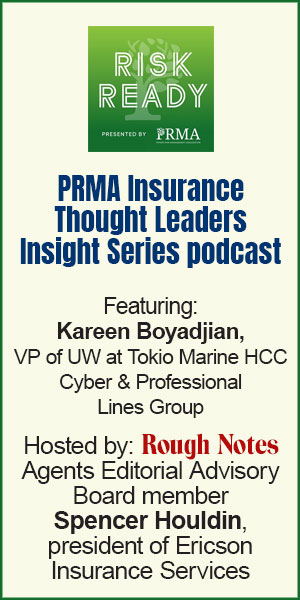Looking “beneath the surface”
to understand and prevent E&O claims
Creating an environment where cascading circumstances
never get started … is the key to eliminating the potential for E&O claims.
By Cheryl Koch, CPCU, ARM, AAI, ACSR, AFIS, and Mary Belka, CPCU, ARM, ARe, RPLU, CIC
We have long considered curiosity as perhaps the most important characteristic of the most successful insurance professionals, including account managers, and have often described account management as an art form. So, it will come as no surprise that as we watched the recent documentary by Ken Burns exploring the life of Leonardo da Vinci, we were struck by the similarities to insurance agency risk management. Perhaps it’s a stretch, and proof that we spend way too much time immersed in all things insurance; yet curiosity remains a differentiating factor throughout history. Risk management—our own art form—is no exception.
Cause and effect
A big component of our work is errors and omissions (E&O) auditing of insurance agencies and working to help them to avoid the preventable before it occurs.
The most common type of E&O claim is “failure to place coverage.” It is nearly always a chain of small, seemingly unrelated events or errors, set in motion, resulting in an omission that is suddenly “discovered” when a loss or triggering event occurs. What is really behind this cause of loss?
It is critical to understand that E&O claims don’t “just happen” or come out of nowhere; most are preventable. Creating an environment where cascading circumstances never get started—or at least are interrupted in time—is the key to eliminating the potential for E&O claims.
Teaching moment number one: Life happens
A commercial lines account manager handles a typical, varied book of business, including a large, growing client with multi-state exposure, navigating changes in their current business environment. Their risk becomes increasingly complex as they make frequent changes to meet their own clients’ demands. Multiple policies are written as properties are added due to carrier limitations regarding their exposures.
The client employs innovative investment techniques for cashflow purposes, taking advantage of recommendations made by their CPA. Some investments require named insured changes, which are requested by the account manager. Meanwhile, the property carrier has moved to a “piecemeal” territorial vs. account approach to underwriting policies on multi-state risks.
The account manager leaves the agency for a new position and is replaced just as the client’s changes are taking place. Several months after the requests for a name change are made, the new account manager receives notice that the new property underwriter, despite detailed explanations, has rejected the request for a change. The general liability carrier has already endorsed the changes. Note: Carriers are not always consistent in their understanding of creative CPA investment approaches.
The account manager struggles to understand whether or not there is property coverage in place for the requested named insureds; there is not. The good news is that no loss has occurred—yet. The bad news: The scramble is on to inform the insured, secure proper coverage and to address any other potential areas not covered.
The replacement account manager now has to undergo a medical procedure, so a third individual unfamiliar with the account is left to get up to speed and work with the producer to replace coverage with a new carrier willing to accept the exposure on a zero timeframe, and to maintain confidence of the insured in the agency.
Teaching moment number two: More real life
A commercial lines account has limited carrier options and is written through an excess and surplus lines (E&S) broker on a claims-made basis. The excess policy is rewritten by the same carrier after several years due to statutory changes and to align with underlying policy terms. After several well-documented conversations, the carrier agrees to retain the existing retroactive date. When the policy is issued, the retroactive date is advanced, creating a potential gap of several years in coverage. This error was not caught or corrected by the carrier or the E&S broker. The only failsafe was the agency account manager’s checking the policy to be sure the coverage ordered was the coverage received.
What helps things go right
In the end, it all works out for both situations—the cascade of events was interrupted, and not all luck is bad. What can we learn from the post-mortem?
- Organizational structure—who does what. Determining the appropriate agency framework is the first step—and often the root cause of claims when there is a lack of clarity.
- Procedures and auditing. The proper processes ensure that coverage is put into place. Failure to place coverage usually means procedures are not in place that ensure that coverage is properly put into effect. Nearly all of the preventive components discussed here are procedures related.
It is worth noting that new employees, or those learning new ways of doing things they’ve always done, tend to revert to old habits they feel served them well when they become overwhelmed. Procedures can go by the wayside in the interest of time and/or comfort.
Auditing is the key to ensuring compliance with established procedures. Understanding just what to audit can be the challenge—and has been discussed in previous columns.
- Transition management. Staff turnover and vacation and medical leaves happen. Handoffs, in general, create “chinks in the armor” and are frequent components of pesky cascading E&O events.
“Plan B” thinking always helps—and team play matters when the going gets tough. Sometimes duties have to be split between several people when temporary absences occur, based on managing multiple duties or lack of relevant skills. This can lead to duplication or, worse yet, process components that don’t get handled at all. The five to 10 largest and/or active accounts should always be reviewed prior to the anticipated change in personnel, for any in-process issues, to ensure understanding and proper handling. Interrupting this potential link in the chain of cascading events is critical to avoiding E&O situations.
- Narratives. Slogging through a trail of documents on multiple policies with many changes can take time—just when time is of the essence. Even a well-documented account can present a challenge to an experienced individual when there are a lot of moving parts to be reviewed on an account with which they are not familiar.
All commercial lines accounts (and large personal lines accounts) should have written narratives outlining relevant, updated account information for those who might have to handle the client, especially in a hurry. These documents are invaluable when new staff is hired, when accounts are reassigned, or as part of a complete submission. They should be updated at least annually.
If you haven’t created narratives, start with your largest, most complex accounts until all are completed. Helpful information may include a brief account history, product and/or operations overview, ownership information, rejected coverage, risk management and/or loss control information, historical loss data, and more.
- Clear change request procedures. When requests take too long, it is a red flag, and the “one-two punch” follow-up approach can eliminate coverage misunderstandings. This should be used for all communication for the best result— especially for complex issues. It is not enough to keep sending endless back-and-forth email requests.
It is critical to speak directly with an underwriting human being regarding complex changes to ensure their understanding of any issues. This should be documented in writing via email, including the timeframe for completing the request. The client should also be made aware in a conversation and email follow-up of any change that is being considered by an underwriter—particularly changes that have not yet been accepted or bound by the carrier.
Elevate issues with the carrier if timely decisions are not made. Letting too much time go by without coverage being clearly bound opens the client and the agency to loss.
- The person ordering the policy—or endorsement—should check it. The march toward parsing the account manager position continues. Those who read our column regularly know we don’t find this to be more efficient and, in fact, it usually increases E&O exposure. That being said, the person most qualified to check a policy contract component is the person who ordered it, provided that person is an insurance professional qualified to handle it in the first place.
“Small things” like retroactive dates get missed when “policy checkers” are unfamiliar with coverage and/or carrier nuances. In the second case mentioned above, the client would have lost $5 million in coverage for an extended period that would likely never have been discovered until an uncovered loss occurred.
- Carrier nuances. When something isn’t working well, it is important to provide feedback and suggestions for change—respectfully. The territorial underwriting experiment/approach we described is being changed, and all properties for a particular account will be handled by the same underwriter moving forward.
- Training and education—and experience. These can never be underestimated. The more someone knows, and the more situations they’ve handled, the better. Learning never ends.
Summary
A curious and innovative mind always asks the question, “Why?” when trying to determine how things work, what happens when they don’t, and how to improve outcomes. Leonardo da Vinci famously—and literally—looked beneath the surface to create arguably the most memorable paintings on earth. Knowledge of anatomy made his subjects come alive. Perhaps applying some of that cross-disciplinary thinking to the understanding and prevention of insurance agency E&O claims will be helpful.
The authors
Cheryl Koch is the owner of Agency Management Resource Group, a California firm providing training, education and consulting to producers, account managers and owners of independent agencies. She has a BA in Economics from UCLA and an MBA from Sacramento State University. She has also earned several insurance professional designations: CPCU, CIC, ARM, AAI, AAI-M, API, AIS, AAM, AIM, ARP, AINS, ACSR, AFIS, and MLIS.
Mary M. Belka is owner and CEO of Eisenhart Consulting Group, Inc., providing management and operations consulting to the insurance industry. She also is an endorsed agency E&O auditor for Swiss Re/Westport. A graduate of the University of Nebraska, Mary holds the CPCU, ARM, ARe, RPLU, CIC, and CPIW designations.





